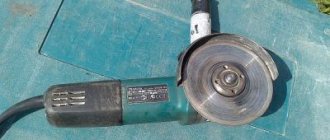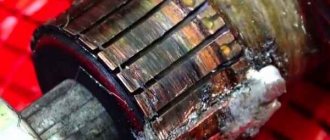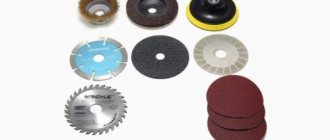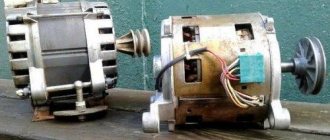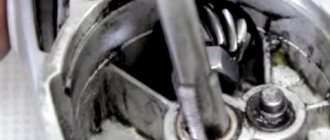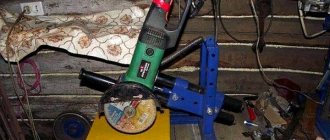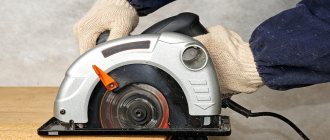How to make an angle grinder speed controller yourself
If you have an old angle grinder in your arsenal, do not rush to write it off. Using a lightweight electronic circuit, the device can be easily upgraded by adding a speed configuration function. Thanks to a conventional regulator, which can be assembled in a home-made environment within a few hours, the functionality of the device will increase significantly. By reducing the rotation speed, the grinder can be used as a grinding and sharpening machine for different types of materials. New capabilities are emerging for the introduction of additional attachments and accessories.
Why does an angle grinder need low revs?
The integrated disc speed control function allows you to delicately process materials such as plastic or wood. At low speeds, operating comfort and safety increases. This function is especially useful in electrical and radio installation practice, in car services and restoration workshops.
Today, among professional users of power tools, there is a strong worldview that the simpler the device is, the more reliable it is. And it is better to take the additional service stuffing outside the unit. In this situation, equipment repair is greatly simplified. That’s why some companies specially produce remote, separate electrical regulators that connect to the machine’s power cord.
Speed controller and soft start - for what purpose are they necessary?
Modern grinders use two fundamental functions that increase the reliability and safety of the tool:
- speed controller - a device designed to configure the number of engine revolutions in different operating modes;
- soft start - a scheme that ensures a slow increase in engine speed from zero to maximum when the device is turned on.
They are used in electromechanical tools, the design of which uses a commutator motor. Helps reduce wear on the mechanical part of the unit during switching on. They reduce the load on the electronic elements of the mechanism, launching them into operation evenly.
As studies of material parameters have shown, more intense production of friction units occurs at the time of a sharp transition from a state of rest to a mode of high-spirited movement. For example, one start of a gasoline engine in a car is equivalent to 700 km of wear on the piston group.
When the power is turned on, an abrupt transition occurs from a state of rest to rotation of the disk with a movement of 3.5.5–10 thousand rpm. Those who have worked with an angle grinder understand perfectly well the feeling that the machine simply “rips out of your hands.” At this moment, the overwhelming number of breakdowns associated with the mechanical part of the unit occur.
The stator and rotor windings also experience the least load. The commutator motor starts working in short-circuit mode, the electromotive force is already pushing the shaft forward, but inertia does not yet allow it to spin. A jump in starting current appears in the electric motor coils. Of course, they are structurally designed for such work; a moment comes (for example, during a power surge in the network) when the winding insulation cannot withstand and an interturn short circuit occurs.
When we include soft start circuits and motor speed configurations in the electronic circuit of the tool, our client is left with the above difficulties that automatically disappear. Apart from everything else, the problem of the “dip” of voltage in the general network at the moment of starting the hand tool is solved. This means that the refrigerator, TV or computer will not be subject to the threat of “burnout”. And the safety circuit breakers on the meter will not operate and cut off the current in the house or apartment.
The soft start circuit is used in angle grinders of the middle and highest price categories, the speed control unit is used to a greater extent in professional models of angle grinders.
Adjusting the speed allows you to process soft materials with an angle grinder, do narrow grinding and polishing - at high speed the wood or paint will simply burn.
Additional electrical circuits increase the price of the tool, but increase the service life and level of safety during operation.
How to make adjustments for an angle grinder at home, homemade options
Some users who have experience working with electrical technologies can make relatively simple adjustment circuit However, it will not be able to effectively adjust the current strength as the speed decreases, and the amount of torque on the operating shaft may be insufficient. This will not be a big obstacle when carrying out work on polishing, cutting thin sheet metal or processing soft materials (plastic and the like).
If making a circuit with your own hands causes difficulties or the nature of work with an angle grinder, for example with stone or ceramics, requires the use of a more complex system with a microcircuit , it is possible to purchase a ready-made block and install it on an angle grinder.
The authors of the videos presented below offer their approaches to the decision to equip an angle grinder with speed control.
A standard dimmer for changing the brightness of lighting is used in the operation of an angle grinder in the following video.
Important: the power of the dimmer must be at least not less than the power of the angle grinder. The quality of polishing work and the smaller amount of dust emitted during it determine the feasibility of modifying the electrical part of the angle grinder using a standard dimmer. This design requires a reasonable dosage of manual load when carrying out work, since overheating of the engine cannot be ruled out and there is a risk of its failure.
A ready-made semiconductor power regulator can be purchased in online stores. The author of the following video purchased a Chinese copy from Aliexpress, and it has quite a lot of power - 4 kW. This value makes it possible to increase the versatility of its application. Many household appliances (grinder, drill, heating elements in the form of heating elements) are operated in power ranges where such a regulator can work quite effectively. The main disadvantage of such regulators is the inability to maintain the load for a long time (the power tool quickly overheats and needs to be stopped to cool down).
The speed of some electric tools can be controlled not only manually using a rotary wheel. Some devices are more convenient to control using pedals . In the following video, the author demonstrates this method of control. Here, a speed controller made in the form of a pedal from a sewing machine is taken and adapted to control an electric jigsaw. There is nothing stopping you from making this option for controlling the angle grinder, but the need for this must be justified by the nature of the work being carried out.
No power loss
It is almost impossible to make a regulator that changes speed without losing power . Such devices with feedback for monitoring the speed value and adjusting the current strength based on them are produced only by manufacturers of angle grinders. You can only make or install regulators on semiconductor circuits , which do not guarantee 100% power conservation when changing the rotation speed of the angle grinder spindle.
How to reduce/increase disk rotation speed
A ready-made inexpensive Chinese-made board can be mounted , as the author of the following video did, in a separate plastic case connected to a cable with a plug and a socket installed on it. By connecting the plug to the electrical network, and the angle grinder to it through the socket, you can change the value of the variable resistance with the adjusting wheel and set the required speed on the angle grinder. Surface polishing with such a power tool will be much better.
How to install, connect
Users of grinders have come up with many different ways to arrange the speed controller and the grinder for which it is intended. It can be located as a stand-alone element outside the body of the angle grinder, or built inside . Below are videos with these options.
In the following video, the author uses a carrying device with an on/off button . Just instead of this very button, a ready-made Chinese semiconductor board is inserted. The technology of electrical installation work was performed at a good technical level. This type of carrier will be convenient to use when using an angle grinder for work that requires the use of low speeds.
Placing additional devices inside the body of an angle grinder can be quite a difficult problem. Often non-trivial decisions , as, for example, in the following video. Here, in order to place a board with speed control and soft start, we had to change the buttons involved in the operation of the on/off lever. In the freed space we managed to place a triac with a radiator for cooling the speed controller and a board with a soft-start microcircuit for the grinder.
How to disable or remove the voltage sensor
In the following video, the author’s speed controller failed on one of the angle grinder models. Attempts to repair it were unsuccessful. The author describes how you can remove a broken regulator and assemble an electrical circuit without it (just connect the stator windings directly through a switch). The grinder will function only at maximum speed.
Circuit operation
Trimmer resistor VR1 changes the charging time of capacitor C1. When voltage is applied to the circuit, at the 1st moment of time (1st half-cycle of the input sinusoid), triacs DB3 and TRIAC are closed. The output voltage is zero. Capacitor C1 charges, the voltage here increases. At a certain point in time, specified by the R1-VR1 chain, the voltage on the capacitor exceeds the opening threshold of the triac DB3, and the triac opens. The voltage from the capacitor is transmitted to the control electrode of the TRIAC triac, which also opens. Current begins to flow through the open triac. At the beginning of the second half-cycle of the sinusoid, the triacs are locked until capacitor C1 is recharged in the reverse direction. Thus, at the output there is a pulse signal of a complex shape, the amplitude of which depends on the operating time of the C1-VR1-R1 circuit.
Subtleties of work
If the regulator is assembled correctly and configured, then turning on the tool will be convenient at low speeds, when there is no jerk. During operation, especially considering the increased danger of angle grinders, it is necessary to make sure that accidental impact on the regulator handle is impossible
This is especially important if the regulator is built into the cord, not far from the body of the grinder itself.
If before this the machine did not have a regulator, then you need to keep in mind that this regulator will tend to maintain speeds close to idle under load, so there is no need to particularly accelerate the angle grinder under a heavy load. When the resistance of the material being processed brakes the disc, the voltage at the current sensor increases due to the increase in current, and the voltage at the motor drops slightly. The microcircuit reacts to this by changing the angle (the moment of unlocking the triac) in the direction of increasing power.
If the current is too high, the protection is triggered and the angle changes in the direction of decreasing power. So you may have to select R9 through experimentation, changing the calculated resistance within small limits.
Installing a homemade board
Ready-made installation recipes are unacceptable. Those who decide to equip an angle grinder with a regulator arrange it in accordance with their goals for the tool model. Some people insert the device into the handle of the holder, others into a special additional box on the case.
In different models, the place inside the grinder body may be different. There is quite a bit of free space for installing a control unit. In others, you have to bring it to the surface and strengthen it using another method. But the trick is the fact that, usually, there is always a certain cavity at the back of the instrument. It is designed for air circulation and cooling.
This is usually where the factory speed controller is located. Of course, place the diagram you made yourself in this place. To prevent the regulator from burning out, thyristors should be installed on the radiator.
Features of installation of the finished block
When purchasing and installing an industrial regulator inside an angle grinder, in most cases you have to modify the body - cut a hole in it to allow the adjustment wheel to come out. However, this may adversely affect the rigidity of the casing. Therefore, it is preferable to install the device outside.
The numbers on the adjustment wheel indicate the number of spindle revolutions. This value is not absolute, but conditional. “1” is low speed, “9” is high speed. Other numbers serve as a guide for adjustments. The placement of the wheel on the body varies. For example, on the Bosch PWS 1300–125 CE, Wortex AG 1213–1 E or Watt WWS-900 angle grinders, it is located at the base of the handle. On other models, such as the Makita 9565 CVL, the adjustment wheel is located at the end of the housing.
The scheme for connecting the regulator to the angle grinder is not simple, but from time to time it is not always easy to stretch the cables to the button, which is located at the other end of the device body. The problem can be solved by selecting a rational cross-section of the wire or bringing it to the surface of the casing.
A good option is to install the regulator on a different device attached to the network cable. Rarely does everything work out on the first try; when you do, you have to test the device and then make some adjustments. This is easier to do when access to its elements is open.
Fundamentally! If you do not have experience with electrical circuits, it is more advisable to purchase a ready-made factory regulator, or angle grinder, equipped with this function.
Device Operation Management
The basic rule when operating an angle grinder with a homemade speed controller is to adhere to the work and rest schedule. It is known that an engine running at a “regulated” voltage in particular gets very hot. When grinding at low speeds, it is important to take frequent breaks so that the commutator windings do not burn out.
It is also highly not recommended to turn on the tool if the speed regulator is set at cinema level - the reduced voltage will not be enough to rotate the rotor, the collector lamellas will remain operating in short-circuit mode, and the windings will begin to overheat. Unscrew the variable resistor to the maximum, then, turning on the angle grinder, reduce the speed to a suitable value.
Following the correct order of activation and adjustment will allow you to operate the angle grinder indefinitely for more than one year.
Today, you should be aware that adjusting the speed of rotation on an angle grinder occurs following the principle of a water tap. The device does not increase the number of revolutions, it can only decrease them. Hence the conclusion is that if the highest rated speed is 3000 rpm, then when connecting the speed controller, the grinder
operates in a spectrum lower than the highest speed.
Attention! If the angle grinder already contains electrical circuits inside itself, for example, it is already equipped with a speed regulator, then the thyristor regulator will not work. The internal circuits of the device simply will not turn on.
Power speed regulator
Work principles
With its help, the electrical device operates at the set engine speed and does not reduce it. The engine speed controller also affects the cooling and ventilation of the motor. With the help of power, the speed is set, which can be either raised or reduced.
Many people have asked the question of how to reduce the speed of a 220 V electric motor. But this procedure is quite simple. One has only to change the frequency of the supply voltage, which will significantly reduce the performance of the motor shaft. You can also change the power supply to the motor by activating its coils. Electrical control is closely related to the magnetic field and motor slip. For such actions, they mainly use an autotransformer and household regulators, which reduce the speed of this mechanism. But it is also worth remembering that engine power will decrease.
Shaft rotation
Engines are divided into:
- asynchronous,
- collector
The speed controller of an asynchronous electric motor depends on the current connection to the mechanism. The essence of the operation of an asynchronous motor depends on the magnetic coils through which the frame passes. It rotates on sliding contacts. And when, when turning, it turns 180 degrees, then through these contacts the connection will flow in the opposite direction. This way the rotation will remain the same. But with this action the desired effect will not be obtained. It will come into force after a couple of dozen frames of this type are added to the mechanism.
The washing machine motor also needs power adjustment. For this purpose, special boards were made that cope with their job: the engine speed control board from a washing machine has multifunctional use, since its use reduces the voltage, but does not lose rotation power.
The circuit of this board has been verified. All you have to do is install diode bridges and select an optocoupler for the LED. In this case, you still need to put a triac on the radiator. Basically, engine adjustment starts at 1000 rpm.
If you are not satisfied with the power regulator and its functionality is lacking, you can make or improve the mechanism. To do this, you need to take into account the current strength, which should not exceed 70 A, and heat transfer during use. Therefore, an ammeter can be installed to adjust the circuit. The frequency will be small and will be determined by capacitor C2.
Next, you should configure the regulator and its frequency. When outputting, this pulse will go out through a push-pull amplifier using transistors. You can also make 2 resistors that will serve as an output for the computer's cooling system. To prevent the circuit from burning out, a special blocker is required, which will serve as double the current value. So this mechanism will work for a long time and in the required volume. Power regulating devices will provide your electrical appliances with many years of service without special costs.
